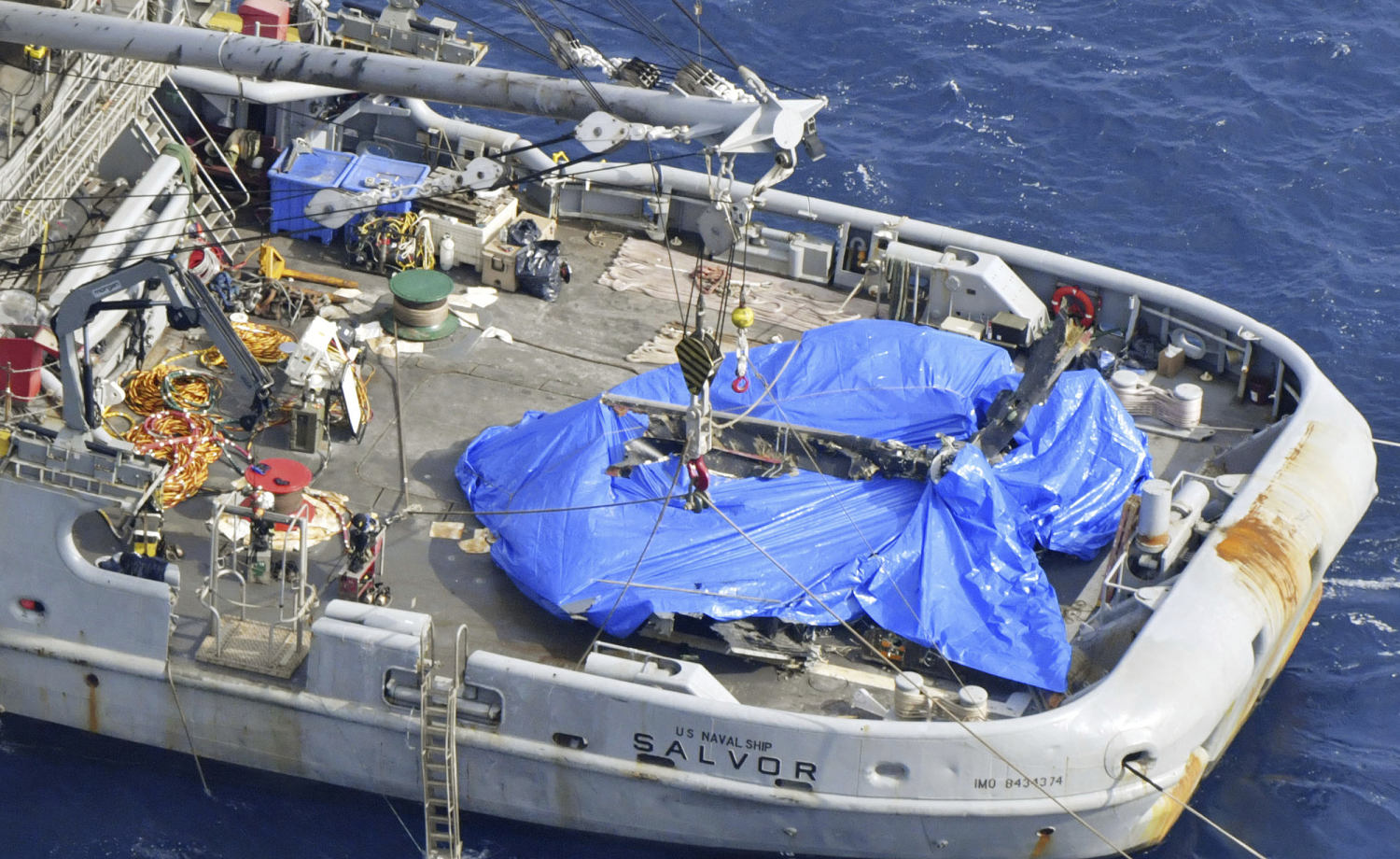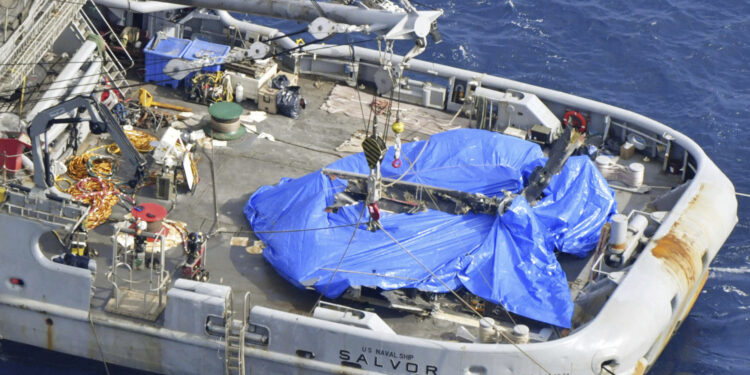
The crash of an Air Force Osprey aircraft eight months ago in Japan that killed all eight airmen on board was caused by a “catastrophic failure” of one of the aircraft’s proprotor gearboxes and the pilot’s “insufficient sense of urgency” to land immediately in response to electronic warnings in the cockpit, according to a crash investigation by the U.S. military released Thursday.
The military has a fleet of nearly 400 Ospreys, a unique aircraft with two adjustable propeller rotors that can rise vertically like a helicopter and fly horizontally like a plane. The 2023 crash in Japan was the fourth and most recent in a series of fatal Osprey crashes that have killed 20 service members within the past two-and-a-half years.
The investigation concluded that a gear failed and broke apart leading to metal chips in the proprotor gearbox, which serves a function similar to a car’s transmission. The root cause of the gear’s failure is still under review by engineers, according to the Air Force.
The issue of possible metal chips in the proprotor gearbox has come up at least seven times in Marine Osprey mishaps since July 2022, according to data obtained by NBC News.
Asked why pilot Maj. Jeff Hoernemann didn’t try to land sooner, the leader of the investigation, Air Force Special Operations Commander Lt. Gen. Michael Conley, said he suspects it was due to commitment to completing a mission — “probably internal pressure to do what they had spent weeks and months planning.”
Conley added that there was no indication the crew deliberately violated any policy and that the crew was highly qualified. “If they were alive today, I would fly with them,” he said.
Attorney Tim Loranger, who represents two families whose loved ones died in the Japan crash, shared a statement emphasizing how no amount of skill or experience could have overcome the catastrophic failure in the gearbox. “The loss of these brave individuals is a profound tragedy, and any suggestion that places blame on those who are no longer here to defend their actions only adds to the deep pain their families are already enduring,” he said.
Conley’s investigation also noted that a lack of sharing of safety assessments between the three services that fly the 386 Osprey aircraft across the military “substantially contributed to the mishap.”
Safety information on the aircraft is handled differently by different branches of the military.
Despite a joint program office that runs the Osprey platform, safety data among services is not universally housed. For instance, the Marines released narratives of serious Osprey mishaps over the past 10 years that included detailed descriptions of what happened in each incident. The Air Force deemed that same information to be “privileged safety information” and not releasable, according to a spokesperson.
The metal chip issue in gearboxes is common enough in the Marines that one safety report noted, “V-22 [prop rotor gear boxes] are known to chip out but there is not a standard reason for why or how often. By submitting these reports we can track frequency of events.”
The Air Force said that in response to the Japan crash they have instructed pilots to immediately land sooner if they get warnings about a metal chip in the gearbox.
The Japan crash
In Japan the crew got its first notification of a possible metal chip about halfway through the approximately 90-minute flight.
That was followed by two more notifications. Standard procedures for the aircraft was to “land as soon as practical,” but a pilot can also use discretion and check to see if there are any secondary indications, according to the crash investigation and a pilot checklist.
Hoernemann, the pilot, determined there were no secondary indications that would suggest a serious problem and continued on his mission. Seventy-one minutes into the flight, the warnings became more serious with what’s called a “chip caution” indicator, which calls for landing as soon as possible, according to the report.
At that point Hoernemann said he was diverting to land at Yakushima Airport, 60 miles away. The report notes this decision “did not indicate a sense of urgency commensurate” with the situation.
After telling the airport he was seeking an emergency landing, and just minutes before the crash, Hoernemann received a “chip detector fail” advisory. That led him say aloud in the cockpit that “he was no longer worried since he assumed the previous warnings were errors due to a faulty chip detector,” according to a cockpit recording cited in the accident report.
But when Hoernemann was on final approach to the airport, the proprotor gearbox catastrophically failed, the rotors stopped working correctly, and the aircraft rolled. “No pilot actions could have saved” the aircraft or the crew, according to the report. In total there were six chip warnings.
The Air Force says it is not releasing any recordings or transcripts of cockpit conversations but said they may be available subject to a freedom of information request.
The eight airmen who died in the crash included Hoernemann, Maj. Luke Unrath, Capt. Terry Brayman; Maj. Eric Spendlove, Tech. Sgt. Zach Lavoy; Staff Sgt. Jake Turnage, Senior Airman Kody Johnson; and Staff Sgt. Jake Galliher.
Unresolved questions
Families of loved ones who died in Osprey crashes have sued the manufacturers of the aircraft and some remain frustrated by a lack of answers as to why the crashes keep happening. An investigation by the General Accounting Office, the nonpartisan congressional agency, is ongoing and the military is conducting its own comprehensive review of the Osprey program that will not be done for another five to eight months, according to military officials. A report on a 2023 crash in Australia in which three Marines died is expected next week.
But questions remain even as the military’s fleet of Ospreys has returned to limited service following the Japan crash.
One persistent question revolves around clutch failures, which were found to be the cause of a June 2022 crash that killed five Marines in California.
That crash was attributed to what is called a “hard clutch engagement,” leading to a redesign of a component of the gearbox. The military has still not determined the cause of the hard clutch engagements.
In an effort to see if the causes of the last four crashes are connected, the House Oversight Committee has been asking the Pentagon for safety investigation reports that are conducted in the immediate aftermath of serious aviation mishaps. This month, the committee chairman, Rep. James Comer, R-Ky., threatened a subpoena if his staff did not receive them by this week.
The Pentagon told the committee that safety investigative reports are not shared to protect the confidentiality of the information.
NBC News obtained a redacted safety investigation report from a 2017 Air Force Osprey mishap caused by a “hard clutch engagement” on the night of Dec. 14, 2017.
Airman 1st Class Jacob Overmyer was on board the Osprey during the incident as crew chief and asleep on the floor when the aircraft suddenly dropped hundreds of feet in the air. He said he scrambled to get to his seat but did not have time to buckle his seatbelt before the aircraft landed.
The incident resulted in no injuries but caused $5 million in damage to the aircraft.
A witness statement from the safety investigation report said once the airmen were on the ground they “saw oil draining profusely out of the [aircraft].”
“It’s pretty insane that this stuff keeps happening,” said Overmyer.
Overmyer told NBC News that weeks after the incident service members on the aircraft were asked to sign a nondisclosure agreement as part of the safety investigation, which is common. Overmyer was deployed elsewhere when the request was made so he did not sign the NDA.
Families who have since lost loved ones on Osprey crashes say the response to the December 2017 mishap was a failed opportunity to learn more about problems that were repeated five years later.
Overmyer says he’s not comforted by the current restrictions that have been placed on the Osprey limiting how far they can fly. “The fact that you don’t always have somewhere safe to land takes away a lot of the safety margins,” he said.







